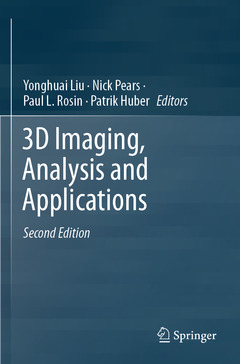3D Imaging, Analysis and Applications (2nd Ed., 2nd ed. 2020)

This textbook is designed for postgraduate studies in the field of 3D Computer Vision. It also provides a useful reference for industrial practitioners; for example, in the areas of 3D data capture, computer-aided geometric modelling and industrial quality assurance. This second edition is a significant upgrade of existing topics with novel findings. Additionally, it has new material covering consumer-grade RGB-D cameras, 3D morphable models, deep learning on 3D datasets, as well as new applications in the 3D digitization of cultural heritage and the 3D phenotyping of crops.
Overall, the book covers three main areas:
? 3D imaging, including passive 3D imaging, active triangulation 3D imaging, active time-of-flight 3D imaging, consumer RGB-D cameras, and 3D data representation and visualisation;
? 3D shape analysis, including local descriptors, registration, matching, 3D morphable models, and deep learning on 3D datasets; and
? 3D applications, including 3D face recognition, cultural heritage and 3D phenotyping of plants.
3D computer vision is a rapidly advancing area in computer science. There are many real-world applications that demand high-performance 3D imaging and analysis and, as a result, many new techniques and commercial products have been developed. However, many challenges remain on how to analyse the captured data in a way that is sufficiently fast, robust and accurate for the application. Such challenges include metrology, semantic segmentation, classification and recognition. Thus, 3D imaging, analysis and their applications remain a highly-active research field that will continue to attract intensive attention from the research community with the ultimate goal of fully automating the 3D data capture, analysis and inference pipeline.
Introduction.- Part I 3D Shape Acquisition, Representation and Visualization.- Passive 3D Imaging.- Active-triangulation 3D Imaging Systems for Industrial Inspection.- Active Time-of-Flight 3D Imaging Systems for Medium-range Applications.- Consumer-grade RGB-D cameras.- 3D Data Representation, Storage and Processing.- Part II: 3D Shape Analysis and Inference.- 3D Local Descriptors -- from Hand-crafted to Learned.- 3D Shape Registration.- 3D Shape Matching for Retrieval and Recognition.- 3D Morphable Models: the Face, Ear and Head.- Deep Learning on 3D Data.- Part III: 3D Imaging Applications.- 3D Face Recognition.- 3D Digitization of Cultural Heritage.- 3D Phenotyping of Plants.- Index
Dr Yonghuai Liu is a full professor and the director of the Visual Computing Lab at Edge Hill University since 2018. He started in September 2001 as a lecturer and then became a senior lecturer in 2011 at Aberystwyth University. He obtained his first PhD degree in 1998 from Northwestern Polytechnical University, P.R. China and second PhD degree in 2001 from The University of Hull, United Kingdom. He is currently an area/associate editor, and editorial board member for various international journals and conference proceedings such as Pattern Recognition Letters, Neurocomputing, American Journal of Educational Research, and IEEE International Conference on Robotics and Automation (ICRA). He won several international awards such as the best associate editor award as an associate editor for the Proceedings of ICRA, 2017. He has published four books and more than 190 papers in top ranked international conference proceedings and journals. His primary research interests liein 3D computer vision, image processing, pattern recognition, machine learning, artificial intelligence, and intelligent systems. He is a senior member of IEEE, Fellow of British Computer Society and Fellow of Higher Education Academy of United Kingdom.
Nick Pears is an Associate Professor in Computer Science at the University of York, UK. He works in Computer Vision and Machine Learning - particularly medical, biometric and creative applications that employ statistical 3D shape modelling. He was recently awarded a Senior Research Fellowship award by the Royal Academy of Engineering (UK) and has had his recent work supported by two Google Faculty Awards. Previously he has worked at the University of Cambridge and University of Oxford, UK, and he gained his BSc in Engineering Science and his PhD in Robotics from the University of Durham, UK.
Paul L. Rosin is a Professor at the School of Computer Science & Informatics, Cardiff University. He has worked on many aspects of comp
Date de parution : 09-2021
Ouvrage de 736 p.
15.5x23.5 cm
Date de parution : 09-2020
Ouvrage de 736 p.
15.5x23.5 cm
Disponible chez l'éditeur (délai d'approvisionnement : 15 jours).
Prix indicatif 116,04 €
Ajouter au panierMots-clés :
3D Imaging; 3D Shape Analysis; 3D Shape Processing; 3D Shape Modelling; 3D Depth Cameras



